11/8/11 How Green Was My Turbine?
Video shows construction work and blasting on Lowell mountain to erect wind turbines.
From Vermont:
LOWELL WIND VIOLATES BLASTING RULES
By Robin Smith, Staff Writer,
SOURCE: The Orleans Record, orleanscountyrecord.com
November 9, 2011
The Vermont Department of Public Service says that Green Mountain Power violated its certificate of public good for the Lowell wind project Oct. 28.
John Beling, DPS director for public advocacy, told state utility regulators this week that protesters were standing too close to the blasting area on the ridgeline, in violation of the certificate requirements.
GMP officials disagree, saying that the department is confusing the blast area at the wind site with the safety zone, which spreads out 1,000 feet beyond that. GMP says the blast area has been strictly controlled.
Also this week, police have continued to carry out a court order to move protesters away from the blast safety zone.
Opponents last week complained to regulators on the Vermont Public Service Board about the blasting needed to erect 21 industrial wind turbines next year.
An attorney for the towns of Albany and Craftsbury said several protesters said they saw blasted “fly rock” and a piece of blasting mat fly outside of the blast area onto neighboring land owned by opponents Don and Shirley Nelson.
Beling said there is a dispute about whether fly rock was propelled onto the Nelson property.
The violation occurred, Beling said, not because of the fly rock complaints, but because “there were a number of individuals present who were not authorized to be present in the ‘blasting area’ and who could have been struck by blast debris. This is a violation of condition 36 of the CPG,” Beling wrote.
On Oct. 28, GMP had not received a court order that state police could act on to move protesters away from the 1,000-foot blast safety zone. As of that day, protesters refused to move, and the GMP contractor reduced the size of the blast zone by using more blast mats and a smaller charge, GMP officials told the Public Service Board.
Protesters said debris did fall outside the blast area into the safety zone even though they were told it would not.
GMP contractors acknowledged that there were protesters within the 1,000-foot safety zone on that day.
However, GMP’s attorney said that there was no one in the “blasting area” which was located entirely on the wind project site and not on the neighboring Nelson property where the protesters were standing.
The blast Oct. 28 was smaller because of the protesters, was within the blast area, and was consistent with the certificate of public good, GMP attorney Peter Zamore wrote.
“All blasting has been conducted safely and in accordance with the CPG, all applicable rules and regulations and industry best practices,” GMP spokeswoman Dorothy Schnure said Tuesday.
“While protesters have been camped out on the mountain, the blasting company has postponed blasting, reduced the size of blasts, used matting and other safety measures to allow limited blasting to occur safely while the protesters refused to move and continued their efforts to stop construction from proceeding,” Schnure said in a statement.
“The DPS is mistaken in its suggestion that any blasting was not consistent with the CPG,” she said. “We are confident when the facts are understood, the PSB will agree that all blasting has been safe and in compliance.”
GMP had a restraining order in effect Oct. 28 and could have called in law enforcement officers, Beling wrote.
But in fact, police said that particular court order could not be enforced, and that’s why GMP did not have police on the wind site.
Beling did not note that in his brief. He did comment on GMP’s efforts to keep people safe.
“The department recognizes the difficult position GMP and its contractors are in,” Beling wrote. “However, GMP must adhere to the terms of the CPG and its blasting plan and ‘prevent unauthorized entry before each blast.’
“At this juncture, GMP has obtained a preliminary injunction from the Orleans Superior Court that should serve to prevent further instances of people being present within the safety zone when blasting occurs, assuming its terms are enforced,” Beling wrote.
“The department does not believe the board need do anything further in that regard,” he wrote.
The department is prepared to make a recommendation about the sanctions, if any, which would be needed if the board finds that GMP did violate its certificate, he wrote.
The department said police presence should prevent further violations.
On Monday and Tuesday this week, law enforcement officers accompanied by police dogs carried out the superior court order and escorted protesters out of the safety zone on the Nelson land. No one has been arrested or cited on contempt of court charges, as far as GMP is aware, Schnure said.
Protesters documented the police activity on their website, Lowell mountain news.
They said that eight to 10 officers and two police dogs were present to read the order on the Nelson property.
On Monday, there were three blasts scheduled, Schnure said.
Police read the court order clearing the safety zone in the morning on Monday to Dr. Ron Holland of Irasburg, a regular protester at the site, and Chris Braithwaite, publisher of The Chronicle of Barton, Schnure said.
They were served the notice and left the zone, she said.
Two more blasts were conducted Monday, with no one protesting the second blast and a small group of protesters moving out of the zone before the third blast, she said.
On Tuesday, police read the order to four protesters in the morning. They left the safety zone, Schnure said. There were no protesters present at the 1:55 p.m. blast. She did not have details about the afternoon blast.
The Record asked for a report from the Vermont State Police about activity on Lowell Mountain this week but had not received anything as of late Tuesday afternoon.
NOTE FROM THE BPWI RESEARCH NERD: Despite protest from landowners and those concerned about Lowell Mountain, a pristine ridge top in Vermont, construction of a industrial scale wind project continues at break-neck speed.
The 400 foot tall turbines must be on line by December 31st to be eligible for a multimillion dollar government grant and tax credits also worth millions.
The wind industry claims there is little to no damage to the land where industrial scale wind turbines are constructed.
11/8/11 400 foot wind turbines VS two-ounce songbirds. Guess who wins.
BIRD KILL AT LAUREL MOUNTAIN INDUSTRIAL WIND FACILITY
By Peter Shoenfeld, The Highlands Voice,
SOURCE West Virginia Highlands Conservancy, wvhighlands.org
November 7, 2011
On October 1st and 2d, approximately 500 birds were killed in an accident at the new Laurel Mountain industrial wind facility, according to Division of Natural Resources Ornithologist Rich Bailey. The fatalities occurred by collision and exhaustion at the Laurel Mountain substation, where the lights were left on during foggy weather. Over thirty species of mixed migratory songbirds were included, primarily blackpoll warblers. A Green Heron was also a victim and is mentioned here to emphasize the general nature of this avian threat. DNR may recommend that lights be turned off there in the time period August 1 through November 1, or an even broader length of time.
The birds were found October 3 by AES staff and reported to contractor Stantec, who took main responsibility going forward, including notification of Division of Natural Resources and United States Fish and Wildlife Service that day.
DNR expects to have a press release on this matter in early November, five weeks or more after the actual event. A detailed report from Stantec to USFWS is available on the incident, subsequent recoveries, and mortality from the USFWS field office in Elkins as we go to press November 1. This is the most thorough narrative currently available. Developer/Operator AES has chosen to remain directly silent about the event, as has the Elkins Intermountain who was notified weeks ago. The story was covered by the Charleston Gazette.
A similar event occurred at the nearby Mountaineer Wind Facility on May 22-23, 2003. Unusually heavy fog enshrouded the region the night of the 22d and persisted until the afternoon of the 23d. Bright sodium vapor lights were left on at a substation and an estimated 33 songbirds were killed by collisions.
There was also a major bird kill due to excess lighting in fog at Tucker County High School, just down the road from Mountaineer on September 29, 2008. About 500 birds were killed, most of them warblers.
Other similar events have been documented in West Virginia at least twice in the not too distant past.
Through their short collective memory and other failings, the wind facility operators are fast earning a reputation as unfit stewards of the little bit of nature left after their developments are complete.
Early on the morning of September 29, 2008, a large bird kill at the Tucker County High School near Hambleton, West Virginia, was reported to Division of Natural Resources personnel. DNR Wildlife Resources Section (WRS) biologists, along with conservation officers, representatives from the Tucker County Health Department, the U.S. Fish and Wildlife Service (USFWS), and the U.S. Forest Service responded to the report and found evidence of a large bird strike at the school.
Officials recovered 501 birds representing 31 species at the site. Seven birds recovered and were released alive. The remaining 494 specimens were collected and identified by WRS biologists. More than 80 percent of the birds were warblers. Bird banders from the Allegheny Front Migratory Observatory and Powdermill Nature Reserve verified the identifications.
Officials collected the majority of the birds along or near the outside walls of the school and from the school roof. Some specimens were also collected from the adjacent parking areas and athletic field. All evidence was consistent with a large scale collision event. Initial speculation suggested that disease and/or poisoning caused the deaths, but no evidence supports this claim.
Additionally, as part of standard procedure, officials from the West Virginia Department of Health and U.S. Department of Agriculture tested sample specimens for both West Nile Virus and Avian Influenza. All samples tested negative for both diseases. An additional sample was sent to the Southeastern Cooperative Wildlife Disease Laboratory in Athens, Georgia, for necropsy. All specimens examined at this facility exhibited trauma consistent with a bird strike, including extensive hemorrhage, and fractured skulls, wings and legs.
Officials from the WRS and the USFWS are working with the Tucker County School Board of Education and Allegheny Power to remedy the situation at the Tucker County High School. They will modify existing lighting to make the site less attractive to migratory birds. The site will be monitored for additional mortality for the remaining 2008 migratory period and this monitoring effort is planned to continue into future years.
In the case of bird kill at Laurel Mountain industrial wind facility it is unclear what the response will be. Because of the public silence of the Developer/Operator AES it is unclear what steps it has taken or will take to investigate the kill as well as what steps it plans to prevent future incidents.
The peak of neotropical songbird migration occurs in late September and early October and is concentrated along mountain ridges. Large bird strikes like the Tucker County High School event are not uncommon throughout North America during this time frame.
Events like these occur when several environmental conditions occur simultaneously in proximity to a lighted man-made structure. These conditions typically include dense fog, southerly winds and a dome of artificial light surrounding a structure. The event can be further amplified by a period of rain prior to the event that concentrates birds by delaying migration.
This was the case with the Tucker County event. Three days of rain prior to September 29 were followed by a passing cold front that generated southerly winds and ideal migration conditions. These birds headed south, encountered dense fog along Backbone Mountain, were attracted by the dome of light surrounding the school, became disoriented, and began to circle the structure, crashing into windows and the outside walls. Some birds may have died from exhaustion from constant circling.
Similar events have been documented in West Virginiain the past. Forty birds of 14 species died on October 5, 1999, in Monterville in Randolph County; and at Snowshoe Mountain Resort in Pocahontas County on October 15, 1985, officials collected 1,336 birds of 30 species.
11/7/11 Look what they've done to our fields, Ma: Wisconsin's newest wind project as seen from the air AND Wind developers in Illinois are no better
THE VIEW FROM ABOVE: FARM FIELD FRAGMENTATION IN WE ENERGIES GLACIER HILLS WIND PROJECT IN COLUMBIA COUNTY, WISCONSIN.
Photos by Jim Bembinster
Photo by Jim Bembinster, Columbia County WI 2011
NOTE FROM THE BPWI RESEARCH NERD: Wisconsin farmers sign on with wind developers because it seems like easy money. They are told they can farm right up to the turbine foundations. They are told about a quarter acre of land will be taken out of production for each turbine.
What they are not told is there will be access roads and trenching for each turbine that will go where the developer wants them to go, crossing at diagonals in the middle of fields, and in some areas compacting the soil so badly crop production is affected and drain tiles are crushed. The farmer is not told that the they've given the wind company the right to use the land as it wishes. It's all in the contract, if you know how to read a contract, or take that contract to a lawyer to read over for you.
The photos below were recently taken by Jim Bembinster. They show a wind project in Columbia County being built by We Energies and the newly fragmented farm fields.
To see larger versions of these pictures CLICK HERE
Better Plan will be posting more photos by Jim Bembinster of the Columbia County We Energies wind project in upcoming days

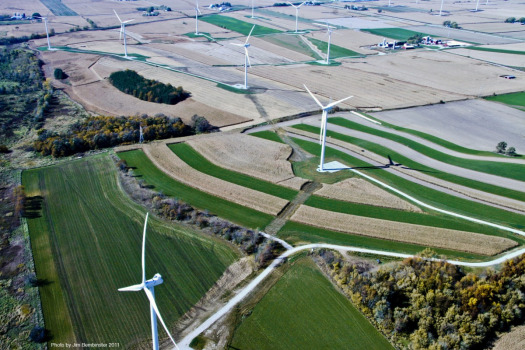
 Photo by Jim Bembinster, 2011 We Energies Glacier Hills wind project, Columbia County WI
Photo by Jim Bembinster, 2011 We Energies Glacier Hills wind project, Columbia County WI

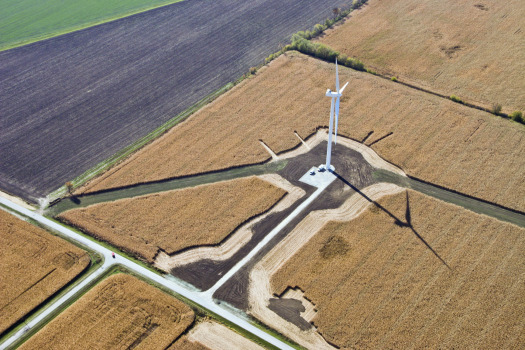

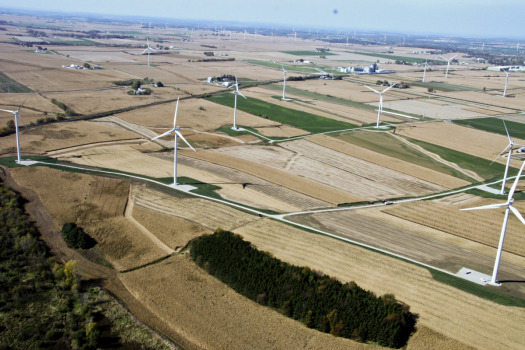
FROM ILLINOIS
FARMER UPSET WITH WIND COMPANY
BY DAVID GIULIANI, www.saukvalley.com 7 November 2011 ~~
COMPTON – Gale Barnickel, a Compton farmer, says he’s not against the wind farm being built in his area.
He and his parents decided against having turbines on their farm, but he said they respected the rights of others to have them.
“We have no problems with what the neighbors want,” he said.
Now, he is alleging that wind energy company Goldwind USA has been repeatedly trespassing on his family’s property. And that has resulted in crop damage, he said.
The property is well posted, he said, so trespassers knew what they were doing.
He brought the allegations to last week’s meeting of the county Zoning Board of Appeals, which is recommending changes to the county’s wind energy ordinance.
On Sunday, Goldwind admitted that its contractor mistakenly crossed into Barnickel’s land.
“When they realized this, they contacted Mr. Barnickel to apologize and address the issue,” spokesman Colin Mahoney said in a statement.
Since then, he said, the contractor has taken “concrete steps” to clearly mark Barnickel’s land, so it’s more visible to construction crews.
At last week’s meeting, those attending expressed concern about Barnickel’s situation. Another wind company weighed in, saying such things shouldn’t happen.
Goldwind, a subsidiary of a Chinese company, is putting up 71 turbines in an area of roughly 6 square miles near Compton in eastern Lee County. It hopes to finish the project – known as Shady Oaks – by year’s end.
In September, a farmer reported that the company had built a road through his cornfield that, he said, was unnecessary. He and another farmer pointed out roads and easements that, they contend, the company mistakenly built through faulty planning.
Other paths for transmission lines were curved, when a straight line would have taken out less cropland, they said.
Unlike Barnickel, those farmers allowed wind turbines on their property, which means they’ll get money every year from the company. In the contracts, Goldwind has agreed to compensate farmers for cropland lost in the construction project.
Barnickel has no agreement with Goldwind.
“Something has to be done to control these guys,” he said. “We try to be neighborly, but we’ve caught them mowing down our crops. They’re cutting corners wherever they can.”
Board member Tom Fassler asked Barnickel whether he had called authorities. The farmer said he had filed two reports with the Lee County Sheriff’s Department, but that it was a waste of taxpayers’ money to keep calling out the sheriff.
“It’s nerve-wracking being pushed around,” Barnickel said. “Why should I have to put up with that?”
“You shouldn’t,” Fassler responded.
Franklin Grove Village President Bob Logan, who attended the Zoning Board meeting, said that was what happens when wind farms are rushed through.
“You’re seeing the rush in the southern part of the county,” he said.
Logan warned that the county may face class-action lawsuits because “rights aren’t being respected.”
“It’s not a level playing field,” he said. “We are here to level it.”
John Martin of Mainstream Renewable Power, which plans a three-county wind farm, told Barnickel that “it’s just not right. No company should operate like this.”
The next day, Barnickel’s wife, Christina Barnickel, said in an interview that the state should fine companies that trespass.
“We have tried to stop them and showed them where the property line is,” she said. “You put so much hope and investment in the crop, and then someone knocks it over. It rubs you wrong.”
Mahoney said the company would continue to work hard to make sure it is a responsible neighbor throughout the rest of the project. He noted that the project is complex, with more than 100 workers busy building access roads, erecting turbines and delivering components on site.
“Despite this complexity, Goldwind is committed to minimizing the impact on the local community, including both participating landowners and neighboring landowners alike.”
NEXT FEATURE:
FROM WISCONSIN
More images of field fragmentation in the Columbia County We Energies wind project.
Photos by Jim Bembinster, 2011

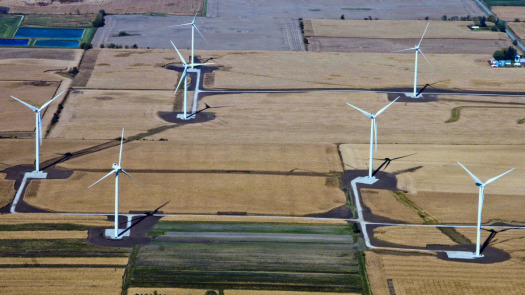

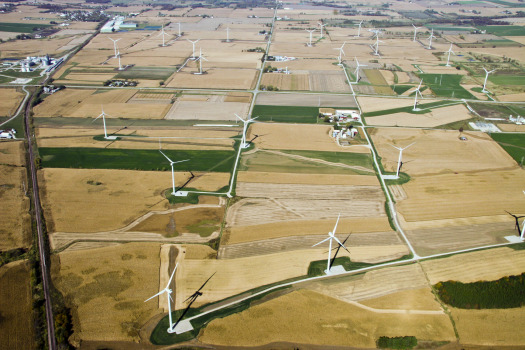
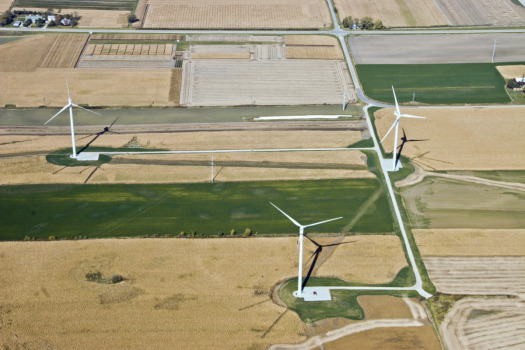



11/4/11 You break it, you pay: Lee County Illinois want's wind developers to give residents property value protection plan AND Same Turbines, Different Continent: the news from Down Under
MORE BACK PROTECTING HOME VALUES; PROPOSAL WOULD HELP THOSE NEAR WIND FARMS
BY DAVID GIULIANI,
SOURCE www.saukvalley.com
November 4, 2011
DIXON – A proposal to protect the property values of homes near wind turbines is gaining support.
Two of the five members of the Lee County Zoning Board of Appeals, which is reviewing the county’s wind energy ordinance, said at their meeting Thursday that they backed a home seller protection program for residents near turbines.
The discussion of the issue started with board Chairman Ron Conderman’s suggestion that the county not include such a program in its ordinance.
“Why add more burden to the county?” he asked.
Members Mike Pratt and Tom Fassler said they would like some version of the program, though.
“Ron, I disagree with you. I’m sorry,” Pratt said.
Two other members, Glen Bothe and Craig Buhrow, didn’t comment on the issue.
The board is basing its review on a proposed wind energy ordinance from Ogle County. That proposal calls for the home seller program to last 5 years after a wind project starts. Pratt pushed expanding that to 10 years.
Pratt wanted the program to affect homes within a mile of turbines, while Fassler suggested 1.5 miles.
The Ogle County proposal details a complex appraisal process, in which the homeowner and the wind energy company each choose an appraiser. In the end, if appraisers find that a home sold for less because it was near turbines, then the wind energy company would pay the difference.
County Assessor Wendy Ryerson has described the proposal as mostly workable, even though she said she hasn’t seen evidence that turbines cause property values to drop.
At Thursday’s meeting, Keith Bolin of Mainstream Renewable Power, which is planning a three-county wind farm, said he didn’t like the program because it would cause conflicts between wind farm companies and their neighbors.
Also, he said, any number of factors can cause a property value to drop, so it would be hard to attribute the decrease to a wind farm.
Franklin Grove Mayor Bob Logan said most wind companies were limited liability corporations. As such, he said, it was up to the county to limit residents’ liability. One way to do that was a home seller program, he said.
“Your obligation is not to help make wind companies get a profit,” he said.
Ryerson said she would bring some proposed language for the home seller protection program for the board’s next meeting on Nov. 17.
The board’s agenda for Thursday’s meeting included the issues of wind turbines’ noise, shadow flicker and the required distance between homes and wind turbines. But the board didn’t have time for those subjects.
The board has been meeting twice a month since the summer considering changes to the county’s ordinance. Its recommendations will be referred to the County Board, which has the final say.
To attend
The Lee County Zoning Board of Appeals meets at 7 p.m. Nov. 17 in the County Board meeting room, on the third floor of the Old County Courthouse, 112 E. Second St.
Go to www.countyoflee.org or call 815-288-3643 for more information.
NEXT STORY
Austrailia
WIND FARM SILENCE DEAFENING
Max Rheese, Weekly Times Now, www.weeklytimesnow.com.au 4 November 2011 ~~
Last week I received an email from a woman I had never met that almost brought me to tears.
It was a cry for help from someone crushed. She told a story of her family’s recent years of bewilderment, frustration, anger and despair.
Samantha Stepnell used to live with her husband and young son on their farm at Waubra, in western Victoria, 900m from the Waubra wind farm.
The family abandoned their home due to chronic sleep disorders experienced since the wind farm started operating.
Over an extended period of time, these sleep disorders degenerated into a range of deleterious health issues.
They have not sold their home; they have abandoned it.
They are not the only ones.
More than 20 homes have been abandoned in western Victoria because of Wind Turbine Syndrome.
Other families do not even have this option and are trapped by circumstances imposed upon them.
This pattern has manifested throughout the world in recent years since wind turbines have grown from the original 50m structures to 150m giants.
A study published last December by Danish researchers Moller and Pedersen linked bigger, modern turbines with increased noise impact.
These bigger turbines have been the preferred choice in Victorian wind farms.
No one claims everyone will get ill because of wind turbines.
Dr Daniel Shepherd and others have concluded from separate studies that 10-15 per cent of the population are more susceptible to noise than the general population.
From their experiences in Europe, multi-national wind energy companies operating in Australia have known since 2004 that health issues have been associated with wind farms – while asserting there are no peer-reviewed studies linking the two.
This was echoed last July by the National Health and Medical Research Council, which stated, “There is no published scientific evidence to positively link wind turbines with adverse health effects”.
It added: “While there is currently no evidence linking these phenomena with adverse health effects, the evidence is limited.”
Nine peer-reviewed studies have been published or approved for publication in science journals since July – and they link wind turbines with adverse health effects.
The recent Senate inquiry expressed clearly in its recommendations that the Federal Government study the health effects of wind turbines.
Since then the Victorian Government has amended planning legislation for new wind farms to require a 2km setback from residences, a 5km setback from 21 nominated regional towns and no-go zones in several regions of the state.
While this recognition of the problem is welcome, it does not address the turbines approved under old guidelines in the lead-up to the last state election.
When constructed, these new approvals will triple the number of turbines to affect 43 different communities in Victoria, with many of these turbines less than 2km from homes.
With the benefit of recent acoustical studies and medical papers, it has become increasingly clear there is a link between wind turbine operation and health effects, the only question is to what degree and what action to take.
The state has a duty of care to those who live in the communities earmarked for wind farms.
It is distressing that we can get public policy so wrong so much of the time and then take so long to fix it.
Max Rheese is executive director of the Australian Environment Foundation
11/3/11 What are the wind rules in Walnut, Illinois?
REGULATING THE WIND TURBINES
By Barb Kromphardt,
SOURCE: Bureau County Republican, www.bcrnews.com
November 2, 2011
WALNUT — What if you held a public meeting and nobody came?
It was a nearly empty house at Tuesday’s second meeting of the Walnut Planning Commission to consider an ordinance to regulate wind turbines outside the village limits.
It was a very different scene three months ago, when about 60 residents, both for and against the wind turbines, crowded the meeting room to make their opinions heard. The planning commission took no action at that August meeting, instead choosing to send the ordinance back to the village board for more work.
After months of special meetings, the board hammered out a new ordinance, and Village President Robert Brasen was at the meeting to explain the ordinance and answer questions.
Brasen read through the 26-page proposed ordinance, highlighting the changes. The new ordinance would prohibit anything within one mile of the village limits, and required approval for anything within the one to one and one-half mile range.
Turbines would be limited to the northwest and southeast corners of the village, which are the business and industrial sections.
Developers must apply for a conditional use permit, with a $5,000 non-refundable fee, for each turbine. Each application must include a commencement and completion date, a decommissioning plan, a plan for addressing complaints, and a property value protection plan, which would guarantee the value of the property of all non-participating property owners within two miles. Turbines would be limited to 450 feet in height.
Brasen said the “stickiest” issue for the board was the distance from the tower to any primary structure. The board set the distance at one-half mile, but allowed for the property owner to request a waiver. The turbines must also be set back from adjacent property of non-participants by at least three times tower tip height.
Brasen said under the current plans for Walnut Ridge, the ordinance would affect two turbines, but there could be more in the future, including some with the proposed Green River Wind Farm on the village’s north edge.
Commission member Gary Sarver said he had heard that if the village passes the ordinance, the developers will simply stay outside the 1.5 mile ring.
Brasen said that after the ordinance is passed, the county can’t override the village and approve any turbines within the 1.5 mile radius. The village can approve the ordinance because it has an existing zoning ordinance, unlike many other small towns.
Planning commission members had several concerns. Chairman Steve Schlumpf wanted a guarantee to restore all roads and other structures within six months to be increased to one year, following a full freeze and thaw cycle.
Committee member Ron VonHolten suggested several changes, including eliminating a section that would have allowed shadow flicker problems to be addressed with plantings or awnings. He also said complaints should include shutting down the turbine from 10 p.m. until 7 a.m. until the problem is fixed.
“If it’s noise issues, you can’t say, ‘Well, in 60 days, I get to sleep,’” he said.
Quoting Dr. Carl Phillips, who recently testified at the Lee County Zoning Board of Appeals, VonHolten said the setback from non-participating property owners should be at least one mile due to health issues affecting 20 percent of residents.
Schlumpf also questioned the property value protection plan. Brasen said no one else currently has the plan, but that it would be binding.
The commission unanimously approved a list of changes to be sent back to the village board for consideration. Brasen said the board would review the changes, and return the final form to the commission at a meeting set for 7 p.m. Nov. 15.
Brasen said the village board can approve the ordinance without the commission’s approval, but it would take a 75 percent vote instead of the usual majority.